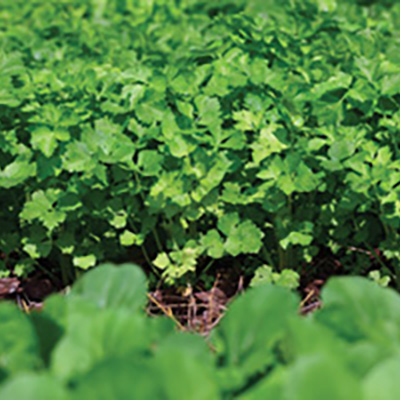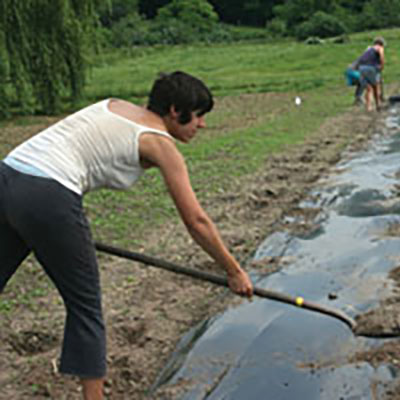Our love of sweet potatoes started with a courtship, naturally. The younger author was dating her future husband in upstate New York and invited her parents to meet him and see his farm.
Market growers with a Yankee disposition, we regarded sweet potatoes as a cloying southern accompaniment to marshmallows, and the source of endless and pointless debate as to whether the particular tuber is a yam or a sweet potato. As botanists, to us they are just tuberous-rooted morning glories.
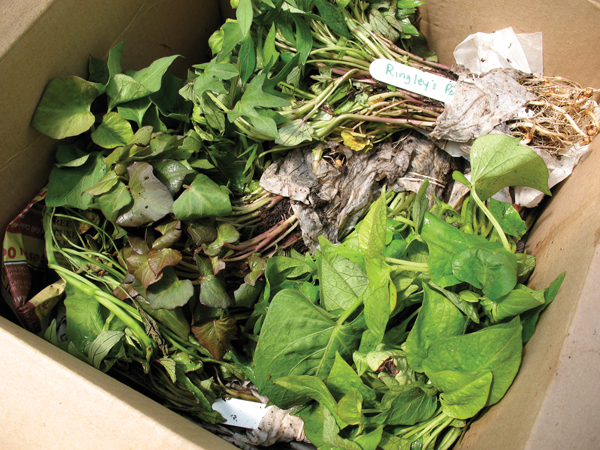
Sweet potato slips from Sand Hill Preservation Center. Even in shipping, some of the upper nodes have roots emerging. All photos courtesy of Ayers Creek Farm
Prejudices die hard, and sometimes deliciously. For our introductory dinner, a colleague offered a selection of his sweet potatoes. There were about a dozen varieties sliced, tossed in oil and roasted. There were white, yellow, orange and purple fleshed varieties in a jumble, obscuring the distinctions so irresistible to some. The resulting mix introduced us to the many dimensions of sweet potato texture and flavor, too often dulled by poor storage and chilling damage.
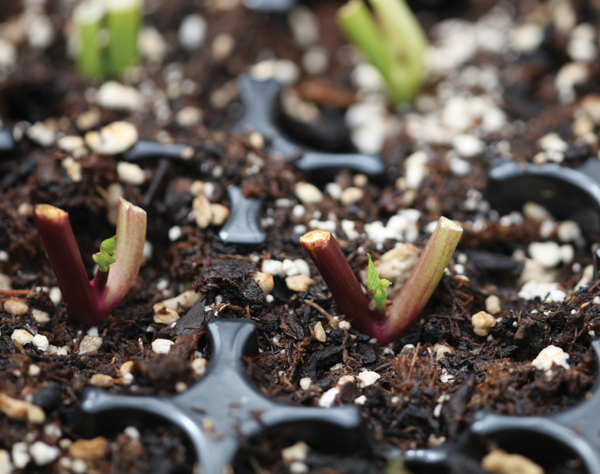
Single node cuttings three days after planting.
Our eyes and palates were opened during that dinner, and we were converts. On arriving home, an order for about 20 different varieties went to Glenn and Linda Drowns of Sand Hill Preservation Center (www.sandhillpreservation.com) for the spring of 2007. At the time, Sand Hill was the only source of certified organic slips, and they offered over 100 different varieties. Today the Drowns’ collection now exceeds 200 varieties. Because of the nature of their operation, some varieties had very limited quantities available, sometimes as few as five slips. No instant gratification, but the patient grower is well rewarded.
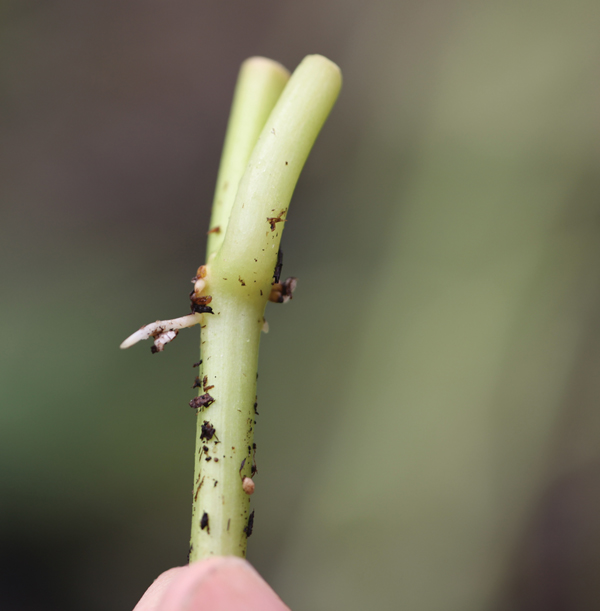
At three days, roots are already emerging from the node.
Coincident with our epiphany, the Organic Seed Alliance invited us to participate in a couple of variety trials, so we selected sweet potatoes. The trial went well, and we now grow a population of mixed sweet potatoes derived from that work. In the spirit of the meal where we first enjoyed sweet potatoes, we grow and sell them as a mix, rather than as individual varieties. We understand that, in some regions, there are strong cultural affinities for certain colors and textures in the root. It is folly to ignore such traditions, though, as a general matter growers will benefit from growing as wide a selection as possible.
Sweet potatoes are propagated clonally using the shoots growing from the stored root tubers harvested the previous year. Tubers are swollen tissues that can be derived from either stems or roots which store energy underground during periods of dormancy, and have latent buds for resuming growth when conditions allow. Sweet potato tubers are specialized dormant plants from the Central American seasonal tropics that grow during the cooler, wet season and enter dormancy during the hot, dry season. Consequently, they are best stored in a warm (above 50°F, 10°C), dry location until they are ready to force for slip production. Chill them and kill them. In days gone by, near the stove in the kitchen was the preferred spot. The tubers are brought into a moist, warm location when the time comes for slip production. The details of traditional sweet potato slip production and culture have been ably covered by regular GFM contributor Pam Dawling (February 2007, August 2014).
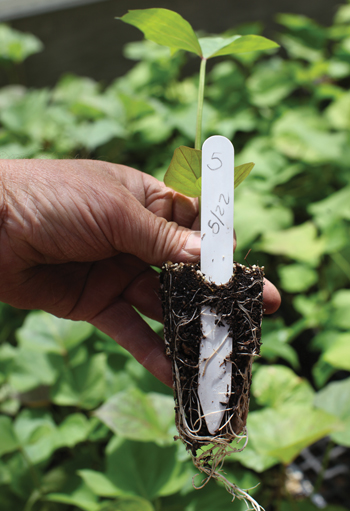
Node cutting at 16 days after planting
We produced our sweet potato slips using these methods until last year. Although we were able to produce a large number of slips; with a mix of sweet potato varieties, traditional slip production was a challenge. The number of slips you can remove from a tuber is limited, some varieties are especially meager in their growing points, and the process takes up a fair amount of space in the propagating area. In cool climates, that means utilizing greenhouse space, always at a premium in the spring. Producing robust slips also requires time. We start the process in late March and plant the slips in the field in early June. With limited propagation space, we were primed for any improvement in the propagation process. Slips are also prone to transplanting shock, delaying their growth. To ameliorate this problem, the slips require daily watering up to two weeks after planting.
Both Ayers Creek and Italy Hill Farm welcome visitors and we learn a great deal when people visit, and often from unexpected quarters. Ayers Creek Farm hosted the 2013 Bean Improvement Cooperative farm visit. Here we had 75 international bean experts roaming the premises and we were about to learn how to improve our sweet potato propagation. Seeing our crates of sweet potatoes curing in the hot greenhouse, John Hart, a participant from Cornell, asked us if we were familiar with the single node propagation of sweet potatoes.
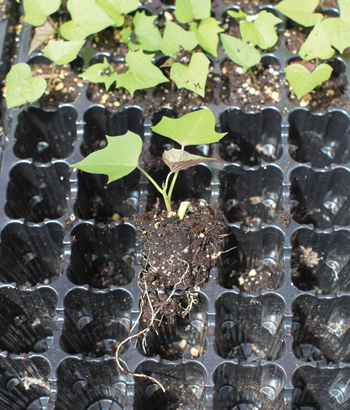
Plants ready to plant in the field at 18 days
With single node propagation, as the namesuggests, a single bud instead of a whole shoot is used to generate the new plant. It is much more economical in terms of plant material and time. The resulting plants are smaller and much easier to plant in the field. The resulting crop is better quality because all of the resulting tubers grow from a single node instead of several, concentrating the production. Better yet, there is absolutely no drawback to the technique, at least in our experience to date. Certainly no reason to keep it within the family.
As with traditional slip production, the tubers are placed in moist potting mix in a warm greenhouse. We start the process about the same date, but use fewer tubers. Using just the nodes rather than complete shoots, count on at least five to ten times the number of starts per tuber, possibly more. You do want robust growth and long shoots, the bigger the better. The shoots retain their rooting ability throughout the growth cycle.
The time between cutting the nodes and planting out in the field is short, a little over two weeks. This short window allows you to keep an eye on the 10-day forecast. You don’t want to plant out sweet potatoes in cold weather; always bear in mind they are tropical plants.
To prepare the cuttings, cut the shoot just above the node – the swollen point where the leaf emerges. About 3/16 to 1/4 inch (5 - 7mm) is good. Inside of each leaf axis is a shoot bud, and just below the bud is a ring of latent roots. The second cut should come just above the next node down the shoot. This piece below the node acts as a peg or anchor, but is otherwise unimportant to the growth of the plant. Whatever fits in the plug works.
At Ayers Creek, we planted the node cuttings into 50-cell plug trays, without a peat liner and using whatever potting mix is on hand – pre-wetted is easier. At Italy Hill, smaller cell trays were used with no problem than a tendency for the node to pop out of the soil. Poke the shoot segment into the potting mix at a slight angle so the node is at or slightly below the surface, and the leaf bud is pointing upwards. That’s it, keep the trays moist and warm and in a day or so the roots will start to emerge.
Even if you purchase slips, you can use this method with them. Plant the slips in the greenhouse and bulk them up prior to making cuttings. It provides the added advantages of increasing the number of viable plants from your commercial slips and buying more time if the weather is too cold or wet for planting the slips.
One of the great eternal debates among market growers is whether it makes economic sense to remove garlic scapes. If you are tired of that debate, you can mix things up a bit by debating whether it makes sense to remove the leaf on the nodal cuttings of sweet potatoes. Removing the existing leaf makes handling the cutting easier. Perhaps it affects the growth, you all can mull on that, along with the number of angels that fit on the head of a pin.
The paper Hart provided us (Islam et al.) recommended using a growth chamber. We did not find this necessary; a warm, moist greenhouse works just fine. Plug size is not a critical factor, but you want to plant them out in the field before the roots start to curl at the bottom of the plug. Smaller plugs mean less grace time. However, at Italy Hill, where the heavy spring rains kept us out of the field for a couple of weeks, no problems were observed with the delayed planting.
We plant the plugs in well-prepared and moist soil. The single node plants really earn their way at this stage because they are so much easier to handle and plant. At Ayers Creek, we plant sweet potatoes on a tall bed, about eight inches high, which helps warm the soil. Initially, we used IRT plastic film and a row cover, but these provided excellent shelter for rodents, especially voles, negating any minor gain in growth. We now plant them in bare ground and maintain bare space between the rows to cut down on rodent pressure. Foregoing plastic has neither hampered growth nor reduced our production; it just eliminated a tedious chore. A good bed is essential in the absence of plastic. At Italy Hill, where weed pressure is more of a concern than rodents, the plugs are planted in raised beds covered by a biodegradable mulch. At both farms, we use double lines of drip tape to provide good irrigation.
In addition to our regular fertilizer that we use for other vegetables, we apply about 35# (15 kg) gypsum and 10# (4.5 kg) sulfate of potash (SOP) per 100 foot (30 meter) of row. The SOP is sprinkled on the surface along the row, and the plants absorb what is needed through their surface roots. The plants are heavy consumers of potassium, an element essential for sugar (starch) synthesis, and it is a good idea to supplement even if the soil tests indicate sufficient levels of the element. The gypsum loosens our heavy clay soils and the calcium helps build cell wall strength for disease resistance. Looser soil allows for better shaped tubers.
Here is one more useful aside on sweet potato culture. Flower and tuber initiation are triggered by photoperiod. (Somasundarum and Santhosh Mithra) No matter how early you plant them out, the plants wait until the critical day length before building their tubers. Each variety has its own clock. In northern climates, growers should resist planting out the plants too early. The plants will languish if they are slowed down by cold soil or weather, and nothing is gained. In northern latitudes, we have longer days during the summer, so the plants can offset the loss of a few growing days with more photosynthetic hours.
Some growers in the north have experimented with growing sweet potatoes in high tunnels. This does help add another plant family to break up the summer rotation in the high tunnel of solanaceous crops but be aware that the rodent pressure in a high tunnel may negate any increased yield due to warmer temperatures.
Last summer, as we were describing single node propagation to Katie and Casey Kulla of Oakhill Organics, Casey noted there may be other applications for the method. Other crops retain root initials at their nodes, notably tomatoes and peppers. Something to experiment with in the future.
Well grown, cured and stored, sweet potatoes are a marketable crop all through the winter, reaching their peak in flavor during the bleakest months of January and February. The use of single node propagation has made the process of perpetuating our own population much easier. Once again, we express our appreciation John Hart for his suggestion. We listened and it worked as advertised.
References
Islam, A. F. M. Saiful, C. Kubota, M. Takagaki, and T. Kozai. 2002 Sweetpotato growth and yield from plug transplants of different volumes, planted intact or without roots. Crop Sci. 42:822-826.
Somasundarum, K. and V. S. Santhosh Mithra. 2008. Madhuram: A simulation model for sweet potato growth. World Jour. Agr. Sci. 4: 241-254.
Caroline Boutard Hunt operates Italy Hill Farm in Branchport, New York. Anthony Boutard, the elder author, operates Ayers Creek Farm in Gaston, Oregon. He is the author of Beautiful Corn: America’s Original Grain from Seed to Plate. New Society Publishers 2013. Both farms are certified organic and provide a diverse selection of market crops in both summer and winter.
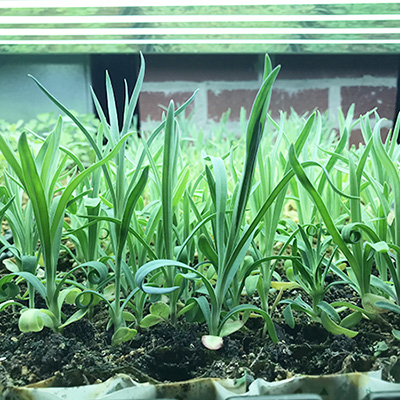
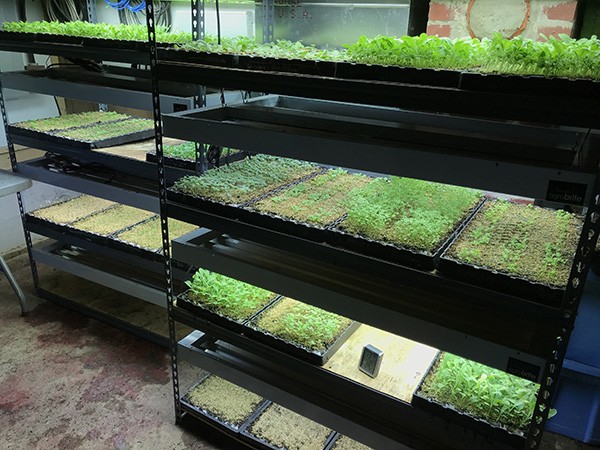 Have you ever lost precious seedlings in your greenhouse to frost? How about tossing a flat or two out due to heat stress or a missed watering? Or better still, stared at a tray of seeds that won’t germinate, with smoke coming out of your ears, because you’re sure someone (not you!) mis-watered them at a critical moment? Have you ever shrugged to yourself reading the growing instructions on a seed packet that says “Germinates best at 70 Fahrenheit” while standing in your 85-90 degree greenhouse? You’ve started to look into a germination chamber to solve some of these issues, but they look pricey and have limitations like not being able to handle as many flats as you’d like to start at once.
Have you ever lost precious seedlings in your greenhouse to frost? How about tossing a flat or two out due to heat stress or a missed watering? Or better still, stared at a tray of seeds that won’t germinate, with smoke coming out of your ears, because you’re sure someone (not you!) mis-watered them at a critical moment? Have you ever shrugged to yourself reading the growing instructions on a seed packet that says “Germinates best at 70 Fahrenheit” while standing in your 85-90 degree greenhouse? You’ve started to look into a germination chamber to solve some of these issues, but they look pricey and have limitations like not being able to handle as many flats as you’d like to start at once.
 Sweet potatoes are grown from “slips,” pieces of stem with a few leaves from a mother root, not from seeds or replanted roots. We used to buy bare-root slips for transplanting because we didn’t know how to grow our own and had heard it wasn’t easy. We have been growing our own for many years now. We prefer the flexibility and reliability it gives us.
Sweet potatoes are grown from “slips,” pieces of stem with a few leaves from a mother root, not from seeds or replanted roots. We used to buy bare-root slips for transplanting because we didn’t know how to grow our own and had heard it wasn’t easy. We have been growing our own for many years now. We prefer the flexibility and reliability it gives us.